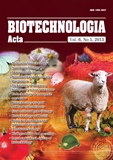ISSN 2410-776X (Online),
ISSN 2410-7751 (Print)

"Biotechnologia Acta" v. 6, no. 5, 2013
https://doi.org/10.15407/biotech6.05.137
Р.137-142, Bibliography 21, Ukrainian
Universal Decimal classification: 582.28:577.158
ACTIVE PRODUCERS OF PEROXIDASE BASIDIOMYCETES STRAINS SCREENING
Donetsk National University, Ukraine
The paper is devoted to the analysis of the research data peroxidase activity of the strains of xylotrophic basidiomycetes in the dynamics of the growth. The objects of study were 57 strains, 5 of which belongs to 5 species of the order Polyporales, and 52 of which belongs to 7 species of the order Agaricales. In order to search for active producers of peroxidase the strains were cultured by the surface method in a liquid glucosepeptone medium. The accumulation of oven-dry biomass was determined by the weight method. The content of soluble protein and peroxidase activity were determined by the spectrophotometry. The studies set the level of accumulation of oven-dry biomass and peroxidase activity of the strains in 9 and 12 days of growth. The results allowed selecting the strains, which are characterized by high levels of peroxidase activity in mycelium and in the culture filtrate, including Agrocybe cylindracea 167, Pleurotus ostreatus Р-кл, Agrocybe cylindracea 960 and 218. These strains which are active producers of peroxidase may be used in the enzyme preparations obtaining technology.
Key words: basidiomycetes, peroxidase activity, mycelium, culture filtrate.
© Palladin Institute of Biochemistry of National Academy of Sciences of Ukraine, 2013
References
1. Lobanok A. G. Biotechnology of microbial enzymes. Nauka i innovatsii. 2011, 1 (95), 66–69. (In Russian).
2. Butsenko L. M. Technologies microbial synthesis of drugs: Teach. guidances. Кyiv: NUKhT. 2010, 323 p. (In Ukrainian).
3. Pyrog T. P. General biotechnology: A textbook. Кyiv: NUKhT. 2009, 336 p. (In Ukrainian).
4. Gavrilova V. P., Shamolina I. I., Belova N. V. Possible innovative use of basidiomycetes in the leather and textile industries. Biotekhnolohiia. 2002, N 5, P. 74–80. (In Russian).
5. Fedotov O. V. Wood–destroying fungi as bio-sources of ferments for medicinal and nutritional purposes. Plant and Microbial Enzymes: isolation, characterization and biotechnology applications. Tbilisi: Myza. 2007, P. 125–126.
6. Wasser S. P. Mushroom Pharmacy. McGraw Hill Encyclopedia of Science & Technology. 10 edition, NY, USA. 2010, Р. 678–683.
7. Lisov A. V. The hybrid Mn-peroxidase fungus Panus tigrinus 8/18: Author. dis. ... cand. biol. sciences: 03.00.04. Skryabin Institute of biochemistry and physiology of microorganisms. RAS. 2005, 16 p. (In Russian).
8. Hofrichter M. Review: lignin conversion by manganese peroxidase (MnP). Enz. Microb. Technol. 2002, V. 30, P. 454–466.
9. Souza-Cruz P. B., Freer J., Siika-Aho M., Ferraz A. Extraction and determination of enzymes produced by Ceriporiopsis subvermispora during biopulping of Pinus taeda wood chips. Enz. Microb. Technol. 2004, V. 34, P. 228–234.
10. Rogozhin V. V. Peroxidase as a component of the antioxidant systems of living organisms. St. Petersburg: GIORD. 2004, 240 p. (In Russian).
11. Davydova G. F., Ermakov O. A., Panasenko A. I., Nishchenko A. M. Medicinal products from plants. peroxidase. Khim. rast. syrya. 1998, N 1, P. 15–18. (In Russian).
12. Presnova G. V., Rubtsova M. Yu., Egorov A. М. Electrochemical biosensors based on horseradish peroxidase. Ros. khim. zhurn. 2008, 3 (2), 60–65. (In Russian).

